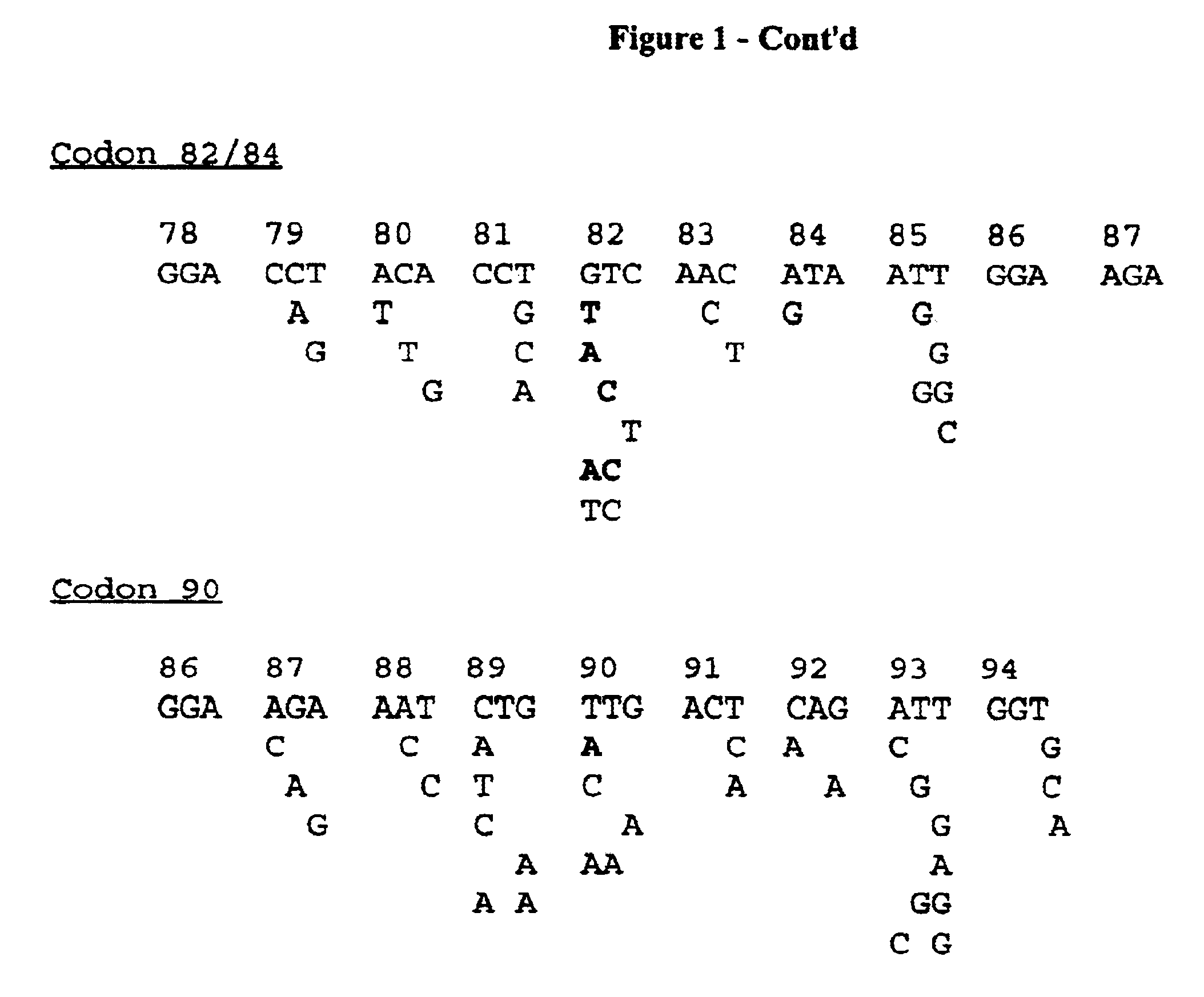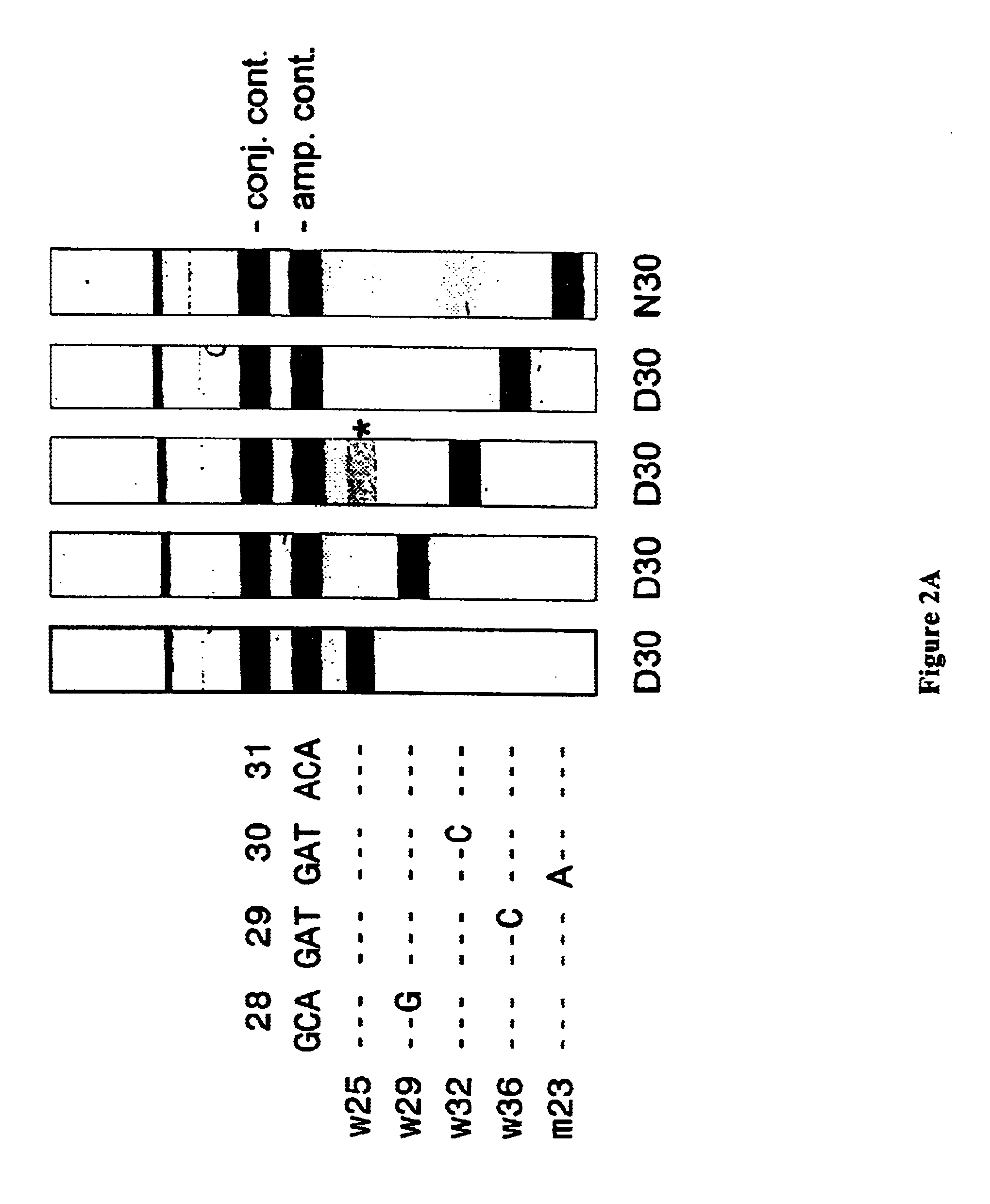Method for detection of drug-selected mutations in the HIV protease gene
a technology of hiv protease and gene, applied in the field of hiv diagnosis, can solve the problems of prolonging the duration of effective antiretroviral activity in patients, unable to completely predict the pattern of amino-acid changes actually seen in patients receiving pi, and delay the emergence of cross-resistant viral strains. , to achieve the effect of rapid and reliable detection
- Summary
- Abstract
- Description
- Claims
- Application Information
AI Technical Summary
Benefits of technology
Problems solved by technology
Method used
Image
Examples
example 1
Selection of the Plasma Samples, PCR Amplification and Cloning of the PCR Products
Plasma samples (n=557) were taken from HIV type-1 infected patients and stored at -20.degree. C. until use. Plasma samples were obtained from naive and drug-treated patients. The drugs involved ritonavr, indinavir and saquinavir. The serum samples were collected from patients residing in Europe (Belgium, Luxembourg, France, Spain and UK), USA and Brazil.
HIV RNA was prepared from these samples using the guanidinium-phenol procedure. Fifty .mu.l plasma was mixed with 150 .mu.l Trizol.RTM.LS Reagent (Life Technologies, Gent, Belgium) at room temperature (volume ratio: 1 unit sample / 3 units Trizol). Lysis and denaturation occurred by carefully pipetting up and down several times, followed by an incubation step at room temperature for at least 5 minutes. Fourthy .mu.l CHCl.sub.3 was added and the mixture was shaken vigorously by hand for at least 15 seconds, and incubated for 15 minutes at room temperature....
example 2
Selection of a Reference Panel
Codon positions involving resistance to saquinavir, ritonavir, indinavir, nelfmiavir and VX-478 have been described (Shiazi et al. 1997). It was the aim to clone in plasmids those viral protease genes that are covering the different genetic motifs at those important codon positions conferring resistance against the described protease inhibitors.
After careful analysis of 312 protease gene sequences, obtained after direct sequencing of PCR fragments, a selection of 47 PCR fragments which covered the different target polymorphisms and mutations were retained and cloned in plasmids using described cloning techniques. The selection of samples originated from naive or drug-treated European, Brazilian or US patients. These 47 recombinant plasmids are used as a reference panel, a panel that was sequenced on both strands, and biotinylated PCR products from this panel were used to optimize probes for specificity and sensitivity.
Although this panel of 47 samples i...
example 3
LiPA Testing on Clinical Samples
A total of 856 samples were tested on this selection of 46 specific probes. The geographical origin of these samples is as follows: USA:359; France: 154; UK:36; Brazil 58; Spain 35; Belgium 199; Luxembourg: 15.
From this population, a total of 144 samples were sequenced which allowed to separate the genotype B samples (94) from the non-B samples (50). After analysis of these genotyped samples on LiPA, the genotypic reactivity on the selected probes was scored. FIGS. 4A to 4F show these results for the different codon positions and for the genotype B versus non-B group. From these tables, it is clear that there is little difference in sequence usage for the different codon positions with resect to specific reactivities at the different probes.
The total collection of 856 samples was then tested on the available 46 probes. After dissection of those reactivities over the different probes and different geographical origin, the picture looks as is presented ...
PUM
| Property | Measurement | Unit |
|---|---|---|
| Tm | aaaaa | aaaaa |
| melting temperature | aaaaa | aaaaa |
| pH | aaaaa | aaaaa |
Abstract
Description
Claims
Application Information
 Login to View More
Login to View More - R&D
- Intellectual Property
- Life Sciences
- Materials
- Tech Scout
- Unparalleled Data Quality
- Higher Quality Content
- 60% Fewer Hallucinations
Browse by: Latest US Patents, China's latest patents, Technical Efficacy Thesaurus, Application Domain, Technology Topic, Popular Technical Reports.
© 2025 PatSnap. All rights reserved.Legal|Privacy policy|Modern Slavery Act Transparency Statement|Sitemap|About US| Contact US: help@patsnap.com



